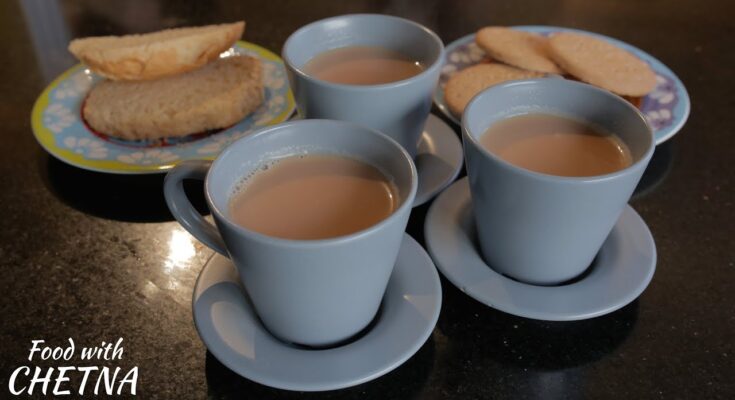Chai Tea Recipe: Chai tea, often referred to as “masala chai” in India, is a rich and aromatic beverage made by blending tea leaves with a variety of spices, milk, and sweeteners. The word “chai” means tea in Hindi, so saying “chai tea” essentially means “tea tea.” This warming drink has transcended cultural boundaries to become a beloved treat worldwide.
A Brief History of Chai Tea
The origins of chai tea date back over 5,000 years in India, where it was originally consumed as a spiced herbal remedy. Over time, with the introduction of black tea from British plantations, the recipe evolved to include tea leaves, creating the chai we know today.
Health Benefits of Chai Tea
Chai tea is not just delicious; it’s also packed with health benefits:
- Boosts Immunity: Thanks to spices like ginger and cinnamon.
- Improves Digestion: Cardamom and cloves help soothe the stomach.
- Energy Booster: Black tea offers a moderate caffeine kick.
- Anti-inflammatory Properties: Ingredients like ginger and black pepper help reduce inflammation.
Ingredients for Making Authentic Chai Tea
Essential Ingredients
To make authentic chai tea, you’ll need:
- Black Tea Leaves or Bags: The backbone of chai.
- Milk: Whole milk is traditional, but options abound.
- Sweetener: Sugar, honey, or jaggery.
- Spices: Ginger, cardamom, cinnamon, cloves, and black pepper.
Optional Ingredients for a Twist
Add a personal touch with these optional ingredients:
- Star anise for a licorice-like flavor.
- Nutmeg for added warmth.
- Vanilla extract for a subtle sweetness.
Choosing the Right Tea Leaves or Bags
Loose black tea leaves are ideal for bold flavor, but tea bags are a convenient alternative. Darjeeling or Assam teas are commonly used for their robust profiles.
Step-by-Step Guide to Making Chai Tea
Preparing Your Ingredients
- Gather your spices: 1-inch piece of fresh ginger, 4 cardamom pods, 1 cinnamon stick, 3 cloves, and 2 black peppercorns.
- Crush the spices lightly using a mortar and pestle to release their flavors.
- Measure 2 teaspoons of black tea leaves or 2 tea bags.
- Have 1 cup of water, 1 cup of milk, and 2 teaspoons of sugar or sweetener ready.
Boiling the Spices and Tea
- In a saucepan, add 1 cup of water and the crushed spices.
- Bring it to a boil over medium heat, allowing the spices to release their aroma.
- Once boiling, add the tea leaves or tea bags and simmer for 2–3 minutes.
Adding Milk and Sweetener
- Pour in 1 cup of milk and stir well.
- Let the mixture simmer for another 5 minutes, ensuring the flavors blend.
- Stir in your chosen sweetener and adjust to taste.
Straining and Serving the Chai
- Use a fine mesh strainer to pour the chai into your cups.
- Serve hot, garnished with a sprinkle of ground cinnamon or nutmeg if desired.
Tips for the Perfect Cup of Chai Tea
Adjusting Spice Levels
If you prefer a milder chai, reduce the amount of spices. For a spicier kick, increase the ginger or add an extra black peppercorn.
Substitutes for Non-Dairy Options
For a vegan chai, substitute whole milk with almond, soy, or oat milk. Each option provides a unique flavor twist.
How to Store Leftover Chai Tea
Refrigerate leftover chai tea in an airtight container for up to 2 days. Reheat on the stove for the best results.
Variations of Chai Tea
Masala Chai
Masala chai is the most popular variation of chai tea, featuring a bold blend of spices. To make masala chai, simply increase the quantity and variety of spices, such as adding fennel seeds or star anise. This variation is perfect for those who enjoy an intense, aromatic tea.
Iced Chai Tea
For warmer days, iced chai tea is a refreshing alternative. Prepare your chai tea as usual, then allow it to cool. Pour over ice and garnish with a sprig of mint or a dusting of cinnamon. Add a splash of vanilla syrup for an extra indulgent touch.
Vegan Chai Tea
Vegan chai tea replaces dairy milk with plant-based options like almond, oat, or coconut milk. Sweeteners such as maple syrup or agave work well to enhance the flavor without compromising on the vegan ethos.
Chai Tea Pairings
Best Snacks to Serve with Chai
Chai tea is often enjoyed with light snacks that complement its robust flavor:
- Biscuits or Cookies: Shortbread or ginger cookies pair wonderfully with chai.
- Savory Options: Try Indian snacks like samosas or pakoras.
- Sweet Treats: Cakes, muffins, or even a slice of banana bread.
Cultural Traditions Around Chai Pairings
In India, chai tea is often paired with savory items like namak pare (salty crackers) or mathri (flaky biscuits). These traditional pairings balance the sweetness of the tea with salty, crunchy textures.
Common Mistakes to Avoid When Making Chai Tea
- Overboiling the Tea: Boiling tea leaves for too long can result in a bitter taste.
- Skipping the Crushing of Spices: Whole spices need to be lightly crushed to release their full flavor.
- Adding Milk Too Early: Milk should only be added after the spices and tea have steeped to prevent curdling.
- Not Adjusting Sweetness: Sweetness is subjective, so taste and adjust as you go.
Why Homemade Chai Tea is Better than Store-Bought
Homemade chai tea offers complete control over the ingredients and flavor profile. Unlike pre-packaged options, you can adjust the spice levels, sweetness, and type of tea used. Additionally, making chai tea from scratch ensures freshness and avoids preservatives or artificial flavorings.
FAQs about Chai Tea Recipe
1. What spices are used in a traditional chai tea recipe?
Traditional chai tea typically includes a blend of spices such as cardamom, cinnamon, ginger, cloves, and black peppercorns. Some recipes might also include nutmeg or star anise for additional flavor.
2. Can I make chai tea without sugar?
Yes, you can make chai tea without adding sugar. If you prefer a sweeter taste without sugar, consider using natural sweeteners like honey, agave syrup, or stevia.
3. Is chai tea caffeinated?
Chai tea usually contains black tea, which is caffeinated. However, the overall caffeine content can vary depending on the type and amount of tea used in the recipe. For a decaffeinated version, you can substitute black tea with a decaf variety or a caffeine-free herbal tea.
4. How can I make a vegan version of chai tea?
To make vegan chai tea, simply replace the cow’s milk typically used in chai recipes with a plant-based milk like almond, coconut, oat, or soy milk. Ensure that the other ingredients used are also vegan.
5. How long does it take to make chai tea?
The time it takes to make chai tea can vary based on the recipe, but generally, it involves simmering the spices and tea for about 10 to 20 minutes to allow the flavors to meld. Including preparation and brewing time, expect about 30 minutes to make chai tea.
6. Can chai tea be served cold?
Yes, chai tea can be enjoyed cold. After brewing, let the chai cool down, then refrigerate it. Serve over ice for a refreshing cold beverage. Some people also like to blend it with ice for a chilled chai tea latte.
7. What are the health benefits of drinking chai tea?
Chai tea is not only flavorful but also offers several health benefits due to its blend of spices. For example, ginger can aid in digestion, cinnamon may help regulate blood sugar levels, and cardamom might have antibacterial properties. However, it’s best to enjoy chai tea as part of a balanced diet.
Conclusion
Chai tea is more than just a beverage—it’s an experience steeped in history, culture, and flavor. Whether you prefer a classic masala chai, a refreshing iced chai, or a creamy vegan version, this guide equips you with everything you need to create the perfect cup. Experiment with ingredients, explore new pairings, and savor the joy of chai tea made just the way you like it.



